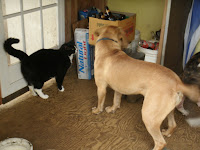 |
| Into each life some sun will shine |
It
has been a little over two years since my Colorado Yurt Co. 24’ high wall yurt
was erected on a sloping piece of land mauka in a rain forest region on the
Hamakua Coast.
Fitting
it out with furnishings and utilities has been an ongoing process based loosely
on the Japanese aesthetic philosophy referred to as Wabi-sabi. This
aesthetic is sometimes described as one of beauty that is "imperfect,
impermanent, and incomplete". Driving this philosophy has been a
combination of personal taste, funds, and the availability of materials. The interior has been furnished with the
highest respect for the beautiful, open vaulted interior space that is so
attractive and pleasing. No walls or
partitions have been permanently constructed, but rather furnishings, fabrics
and other movables have been used to define the living spaces; seating,
storage, sleeping, cooking, etc.
Emphasis has been given to natural materials, such as wooden floors and
furniture, while color has been added with printed wall hangings, blankets,
pillows etc.
Other objects with the theme of
peace have been added both as decoration and to help focus the tranquil tone of
the interior. Closeness to the natural
world is emphasized with views of plants, flowers, Mauna Kea and the Pacific
Ocean from windows, doors, and a small lanai.
Rain in its many forms, the wind in nearby Eucalyptus trees, animal
calls, and a small stream create a peaceful acoustic soundscape.
There is still much to be done in the interior, and in
the spirit of Wabi-sabi these changes will come as the vision matures and the
appropriate furnishings and items make themselves apparent. There is a conscious theme of moving away
from items made of plastic and replacing them (chairs are high on the list)
with re-purposed pieces made of more natural materials that have character and
spirit.
 |
| And that sun can become electric... |
Several utilities and conveniences have been added to
make the yurt comfortable and practical.
Perhaps the most useful modern addition has been the recent completion
of an off-grid photovoltaic electric system.
This system consisting of four solar panels, batteries, a battery
charger and an inverter allows the yurt to support computers, a printer,
lights, a radio, other plug-ins, and a refrigerator. I am still wrestling with a growing number of
black cords and power strips, which challenge the Wabi-sabi aesthetic! The system hardware is located on the exterior
of the yurt; panels in a nearby open area, and the electric devices installed
in a storage closet in an open space under the yurt.
The kitchen, located inside the yurt along the wall,
consists of a granite topped cart that stores cookware and utensils, and a
single burner gas cook top. Interior
water, used for cooking and drinking is carried in by hand at this point. Exterior water, used for washing and bathing,
is collected in 55 gallon barrels and then pumped through hoses to outlets and
to a propane instant-on gas heater. The
finishing touches of an outdoor shower are being currently complete. The shower which is located in an open space
under the yurt features an ocean view!
 |
| Loveable Loo |
A composting toilet, referred as a “Loveable-loo” is
found in the open area under the lanai. Waste
matter mixed with absorbent peat moss is collected in the toilet device and
periodically emptied into the compost bin, elegantly recycling the waste back
to the land.
The composting toilet, photovoltaic electric, catchment
water, and instant on hot water system reflect an ongoing value of living
simply and respectfully on the land while striving to be as independent and
self-sustaining as possible.
The process of building and creating a yurt-home is ongoing
and fulfilling. As Ferris Bueller once
said, “I highly recommend it, if you have the means.”
I consider myself a fortunate and rich man.


















